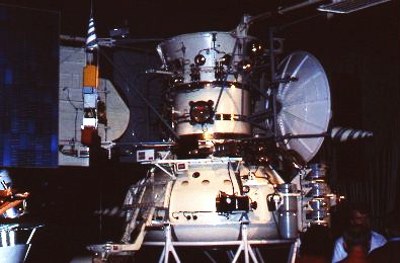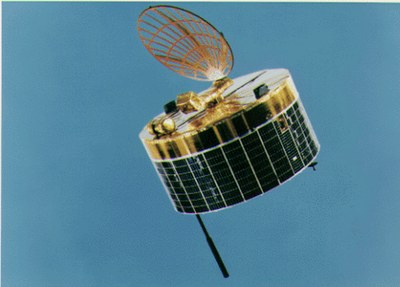A chance of a lifetime: the missions to Comet Halley<< page 1: international missions The missionsThe first spacecraft launched to Comet Halley were the Soviet Vega probes. Vega 1 and 2 were launched from the Baikonour Cosmodrome in Soviet Kazakhstan at the end of 1984 using a pair of Proton 8K82K rockets on December 15 and 21, respectively. Vega 1 reached Venus first on June 11, 1985. As Vega 1 passed 39,000 kilometers (24,200 miles) from Venus, the lander successfully deployed the Soviet balloon payload in the Venusian atmosphere on its way to a landing on Raskala Planitia near local midnight. Four days later Vega 2 passed 24,500 kilometers (15,200 miles) from Venus while its lander also successfully deployed a balloon as it descended to a nighttime landing 1,500 kilometers (930 miles) southeast of Vega 1 in Aphrodite Terra. With their missions at Venus successfully completed, the two Vega spacecraft were on their way to encounter Comet Halley in nine months.
Next out of the gate was the Japanese MS-T5 mission launched from the Kagoshima Space Center on January 7, 1985. After it was successfully launched on a direct-ascent trajectory into interplanetary space, MS-T5 was renamed Sakigake (“Pioneer” in Japanese). The launch had been delayed for three days because of ground equipment problems. As a result, the miss distance from Comet Halley had been increased by almost 3 million kilometers (2 million miles). Course corrections performed on January 10 and February 14 decreased the miss distance to about 7 million kilometers (4.4 million miles). After a series of engineering tests, all of Sakigake’s instruments were turned on by the end of February 1985. The success of this technology demonstrator paved the way for the launch of Planet-A later that summer. The next mission off the pad was the European Giotto mission. It was launched from Kourou in French Guiana on July 2, 1985, on Flight V14 of the Ariane. After spending 32 hours in a 198.5 by 32,000 kilometer (123.4 by 19,900 mile) parking orbit inclined 7 degrees to the equator, Giotto’s MAGE 1S kick motor ignited for a 55-second burn to send the probe into solar orbit. The first course correction was made on August 26 to move Gitto’s initial aim point to within 4,000 kilometers (2,500 miles) of Halley’s nucleus. The last dedicated mission to be sent to Comet Halley was the Japanese Planet-A probe. It was successfully launched on August 18, 1985 and subsequently renamed Suisei (Japanese for “comet”). The launch of the Mu-3SII proved to be so accurate with a miss distance of only 210,000 kilometers (131,000 miles) that a course correction planned for August 22 was cancelled. A course correction on November 14 moved Suisei’s aim point to about 151,000 kilometers (93,800 miles) on the sunward side of Halley’s nucleus. The first of the international armada to reach Comet Halley was the Soviet’s Vega 1. It passed 8,890 kilometers (5,525 miles) from Halley’s nucleus at a relative velocity of 79.2 kilometers per second (49.2 miles per second) at 7:20:06 UT on March 6, 1986. Near closest approach Vega 1 was pummeled by up to 4,000 dust particles each second as it returned ghostly images of the 15-kilometer-long (9-mile-long) peanut-shaped nucleus. Vega 1 survived the dangerous encounter and successfully transmitted about 800 images and other data, but two instruments had been disabled and the output from the unprotected solar arrays was cut by 55%. Next up was the Japanese Suisei, which had been observing Comet Halley with its UV imager since mid-November 1985. It passed at a much safer range of 151,000 kilometers (93,800 miles) at 13:06 UT on March 8 where it secured useful data on the properties of the comet’s extended cloud of hydrogen. Just 18 hours later, Vega 2 made its dangerous plunge towards the nucleus. Its path through Halley’s coma afforded a less obscured view of the nucleus compared to Vega 1. Although the main processor controlling the scan platform failed 32 minutes before closet approach (forcing a switch to a less capable backup system), Vega 2 survived its 76.8 kilometer-per-second (47.7 miles-per-second) encounter with Halley at 7:20:00 UT on March 9 at a range of just 8,030 kilometers (4,990 miles). Vega 2 had several instruments lost or partially disabled during the encounter and lost 80% of the power from the solar panels, although this was later revised to only a 50% loss. In total the two Vega spacecraft returned a total of 1,500 images and a mountain of other data on Comet Halley.
After Sakigake made its distant 6.99-million-kilometer (4.34-million-mile) pass by Comet Halley at 4:18 UT on March 11, the last spacecraft in the international armada was Giotto. Data from the Soviet Vega probes had pinned down the position of Halley’s nucleus to within 75 kilometers at a 99.7% confidence level—a 20-fold improvement over what was provided by Earth-based observations alone. With such an accurate fix, on March 11 Giotto project scientist decide to attempt a 500-kilometer (310-mile) pass by the nucleus and performed a final course correction. Giotto made its closest approach on March 14 at 00:03:02 UT at a range of 605 kilometers (376 miles). It returned 2,112 images of the comet and provided the clearest views we have of Halley’s nucleus. More images would have been returned except that a hard hit by a large dust particle just 16 seconds before closest approach knocked the spinning Giotto’s antenna out of alignment with the Earth. While full contact with the probe was restored 32 minutes later after the wobble was dampened, several instruments were damaged including the camera, whose baffle was severely mauled, rendering it unusable. Despite the dangers, all the members of the Halley armada had survived. Contrary to the earlier opinions of the American scientific community, the data returned from these missions was very useful in beginning to unravel the properties of comets. Despite there being no dedicated American mission, the United States did make some contributions. The US provided much needed tacking coverage using NASA’s Deep Space Network. Individual scientists participated in international science teams as well as provided instruments for Giotto and Vega. In addition to observations of Comet Halley made by Pioneer Venus Orbiter in early February 1986 at a range of 40 million kilometers (25 million miles), two other American spacecraft made distant observations of the interplanetary environment upstream of the comet. Pioneer 7, launched into solar orbit in 1966 to monitor the solar wind, passed 12.3 million kilometers (7.6 million miles) from Halley on March 20 by sheer luck. The ICE spacecraft, which encountered the short-period comet 21P/Giacobini-Zinner on September 11, 1985 (see “The ICE mission: the first cometary encounter”, The Space Review, September 20, 2010), passed 31 million kilometers (19 million miles) from Halley on March 28.
Subsequent encountersAfter the encounters with Comet Halley, further plans were considered for the various spacecraft of the armada. Soviet scientists considered redirecting Vega 2 for a distant 6-million-kilometer (4-million-mile) pass by the near Earth asteroid 2101 Adonis in 1987. Unfortunately, contact with Vega 2 was lost on March 24, 1987, while Vega 1 ran out of attitude control gas three months earlier, on January 30. Despite this, VEGA would prove to be the most successful interplanetary mission ever mounted by the Soviet Union. Japanese scientists also had high hope for their Sakigake and Suisei probes. There were plans to redirect Sakigake towards an encounter with Comet Giacobini-Zinner in 1998, but there proved to be insufficient propellant for that mission. Contact was maintained until November 15, 1995, although its signal beacon continued to be received until January 7, 1999. Scientist also hoped to guide Suisei towards a distant encounter with Comet 55P/Tempel-Tuttle on February 28, 1998, followed by a close flyby of Comet Giacobini-Zinner on November 24, 1998. Suisei changed course in early April 1987 for a planned Earth gravity assist at a range of 60,000 kilometers (37,000 miles) on August 20, 1992. Unfortunately Suisei’s hydrazine propellant was depleted on February 22, 1991, ending hopes for further encounters. By far the ESA Giotto had the most productive life after its encounter with Comet Halley. Giotto adjusted its course to flyby the Earth at a range of 16,300 kilometers (10,100 miles) on July 2, 1990, and subsequently passed about 200 kilometers (125 miles) from Comet 26P/Grigg-Skjellerup on July 10, 1992. Despite the loss of its camera, Giotto returned important data on this comet. Giotto was placed into hibernation 13 days later, ending Giotto operations. There was insufficient propellant left for any extensive maneuvers and Giotto was not reactivated when it flew past the Earth at a range of 219,000 kilometers (136,0000 miles) on July 1, 1999. BibliographyJ. Kelly Beatty, “The High Road to Halley”, Sky & Telescope, Vol. 71, No. 3, pp 244–245, March 1986 R.M. Bonnet, “History of the Giotto Mission”, Space Chronicle: JBIS, Vol. 55, Suppl. 1, pp 5–11, 2002 Louis Friedman, Starsailing: Solar Sails and Interstellar Travel, John Wiley & Sons, 1988 Brian Harvey, Russian Planetary Exploration: History, Development, Legacy and Prospects, Springer-Praxis, 2007 Jeffrey M. Lenorovitz, “Giotto Redirected to Fly Past Earth After Returning Data on Halley’s”, Aviation Week & Space Technology, Vol. 124, No. 12, pp 22–23, March 24, 1986 Yasunori Matogawa, “Giotto: Historical Encounters for Japan”, Space Chronicle: JBIS, Vol. 55, Suppl. 1, pp 31–33, 2002 Robert M. Powers, Planetary Encounters: The Future of Unmanned Spaceflight (Revised), Warner Books, 1979 Paolo Ulivi with David M. Harland, Robotic Exploration of the Solar System Part 2: Hiatus and Renewal 1983–1996, Springer-Praxis, 2009 Andrew Wilson, Solar System Log, Jane’s Publishing, 1987 “New Vega Flyby”, Aviation Week & Space Technology, Vol. 124, No. 12, p 22, March 24, 1986 Home |
|

